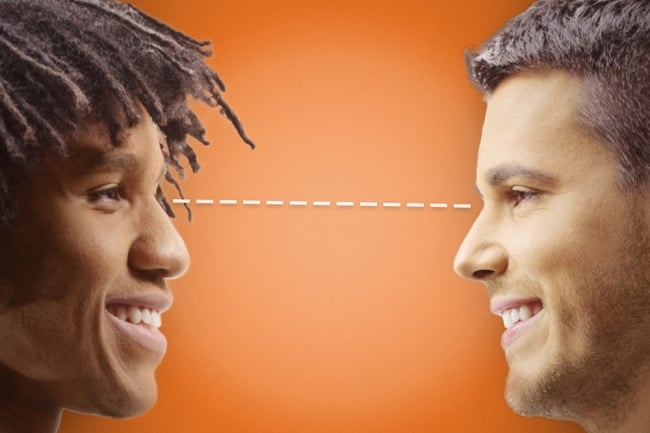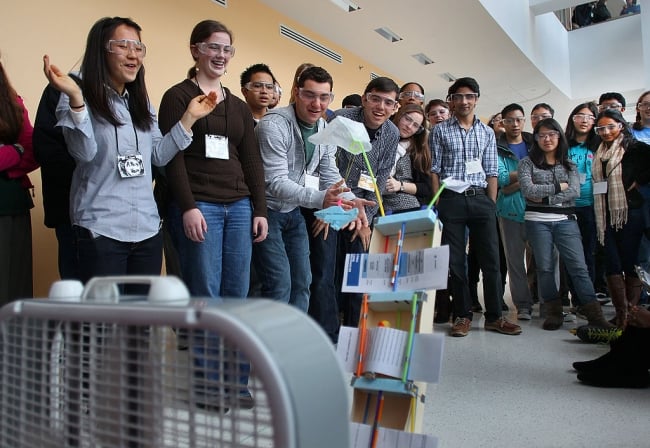You have /5 articles left.
Sign up for a free account or log in.

Amid a sea of big changes in admissions this year, some colleges are experimenting with more in-person contact in the admissions process.
Photo illustration by Justin Morrison/Inside Higher Ed | Getty Images
As higher education contends with the end of affirmative action and a rapidly changing admissions landscape, St. John’s College is trying a novel approach to the application.
Last month the private liberal arts institution in Annapolis, Md., announced a new “discussion-based” application option that students can select over the traditional process. Starting this fall, applicants can forgo submitting essays or test scores and instead choose to be evaluated almost entirely face-to-face, through interviews with admissions counselors and faculty, as well as participation in a college seminar.
St. John’s decision to revolutionize its admissions process is perhaps unsurprising in light of its unorthodox approach to education. The 300-year-old college does not offer traditional majors; instead, all students follow one common interdisciplinary curriculum featuring 200 “great books” from Plato’s Republic to James Baldwin’s The Fire Next Time. Its students, affectionately referred to as Johnnies, have a reputation for reveling in debate for its own sake, earning St. John’s the epithet “most contrarian college in America,” which it has embraced wholeheartedly.
Benjamin Baum, St. John’s director of admissions, said the new application option aligns with the college’s distinct assessment policies, which are largely based on in-class discussions, and that he hopes the process will attract the kinds of students who would thrive there.
“It’s certainly a big departure … but most colleges’ applications look very similar to each other, and until recently so did ours—despite the fact that we think of ourselves as being a very different kind of institution,” he said. “So we thought, let’s break the mold.”
It is a bold experiment, but as institutions across higher education grapple with the new admissions environment, St. John’s focus on high-contact, personalized evaluation may prove to be more of a bellwether than an oddity.
Given the confusion about how to identify or handle admissions essays written by ChatGPT, the impact of pandemic learning loss on college readiness and the Supreme Court’s decision striking down affirmative action, evaluating college applicants is likely to be more fraught than ever this admissions cycle. Some admissions officers believe bypassing the traditional application in favor of a more personal approach could have benefits for a wide range of institutions.
“There are certainly recent changes in the landscape that could lead to more robust usage of these tools,” said David Hawkins, chief education and policy officer for the National Association for College Admission Counseling.
Baum said students can complete the discussion assessment over Zoom if they choose, but he hopes that many will take advantage of the financial support St. John’s makes available to travel to one of its two campuses—there is one in Santa Fe, N.M., as well as Annapolis—to get an in-person feel for the college’s unique pedagogy. Because the admissions process is rolling, St. John’s has already received a few dozen applications for the Class of 2028 and can begin admitting students this month.
Officials still have kinks to work out, including how to compare a traditional applicant with one participating in the discussion-based assessment. But Baum said that’s the nature of experimentation, and if there were a time to jump into virgin territory, he believes it’s now.
Bypassing the ‘Black Box’
According to a NACAC poll of recent and current college applicants released last month, nearly two-thirds of respondents said they felt like “just a number” while applying. One benefit of high-contact admissions practices is that they give faces and personalities to an otherwise impersonal application file, Baum said.
“Most colleges’ applications are basically a black box, where you submit into the void and wait for an answer,” he said. “For us, it will be a much more dynamic process.”
Susan Hartley-Brisson, dean of admissions for Olin College, expressed a similar sentiment. Olin, a small engineering college in Needham, Mass., flies prospective students to campus as part of its admissions process and has done so since its founding in 1997.
After receiving applications but before making admissions decisions, Olin invites about 250 applicants to stay on campus for Candidates Weekend, where they meet current students, take special classes and get a sense for the intellectual and social life of the institution. They also undergo two in-person evaluations: an individual interview with an admissions counselor and a group exercise observed by members of the admissions team.
Hartley-Brisson said the college makes exceptions for international students or those with other obligations, but it greatly prefers that invitees make the trek to Needham.
“We feel that it’s in everybody’s best interest to have them come and see what Olin is all about, because it’s going to be different than what they might experience at any other institution,” she said. “And it gives us an opportunity to see them in action.”

Olin College applicants at a 2012 “candidates weekend” on the Needham, Mass., campus.
John Tlumacki/The Boston Globe via Getty Image
High-contact practices could also be a more equitable way of assessing applicants. Baum said the idea for a discussion-based admissions option started germinating this summer, around the time the Supreme Court handed down its affirmative action decision. And while he insists that wasn’t the impetus for the new policy, he said the ruling “weighed heavily” on how his team thought about implementing it.
The discussion-based option was designed in part for underrepresented students who might feel less comfortable with the traditional application, he said—maybe because they come from underresourced high schools with few counselors and poor college prep courses or are first-generation students whose parents don’t have experience applying to college.
“I’ve seen essays in the past that weren’t successful college admissions essays, and yet when we get those students in conversation, we discover there’s so much potential for them to succeed,” he said. “This is a mechanism for reaching those students and enabling them to really shine.”
Hawkins expressed less certainty that high-contact practices are the best way to increase access, citing the cost and difficulty for many students of visiting a faraway campus or preparing to impress a graduate in an interview. Still, he acknowledged the potential benefits, noting that right now, any change is welcome.
“Historically, interviews and visits to campus tend to tilt the playing field ever so slightly away from equity,” he said. “But I don’t want to draw any bright lines. The admissions system as a whole is fundamentally inequitable, so now is the time to take apart the entire machine and rebuild it with equity as the goal.”
A Special Case or a Growing Trend?
Interviews and campus visits aren’t typically weighed very heavily in admissions criteria. A 2023 NACAC survey of member colleges found that 54 percent said such factors were of “no importance” to admissions decisions, and only 13 percent said they were of considerable or moderate significance.
But recent developments could lead admissions officers to take a second look at face-to-face application components. Concerns about ChatGPT have worried admissions officers since March, and this is the first fall applicants could use the artificial intelligence tool for writing personal essays; a model like St. John’s, Baum said, makes the tool irrelevant.
And with race-conscious admissions now illegal, face-to-face connections could help colleges get around the challenge of determining an applicant’s identity based on their written application, which would allow institutions to continue building diverse classes.
“I firmly believe many colleges will be exploring new ways to see the whole students, especially after the Supreme Court ruling,” Hawkins said.
There are some differences between the approaches at Olin and St. John’s. The former is explicitly focused on STEM, while the latter is devoted to humanities and the classics; Olin is highly selective, while St. John’s admits just over half of its applicants. Yet in other key ways the two are very similar: small, private colleges with the resources and leeway to experiment with their admissions policies, and with unique approaches to education they’re keen to let students experience before applying.
But are high-contact admissions practices feasible for a broader swath of institutions?
Baum said that discussion-based or in-person evaluations might not be the right fit for all institutions, but the moment calls for more experimentation in admissions.
“This is not a cheap or simple model, but it could be a powerful tool for small liberal arts schools,” Baum said. “At the end of the day, this works for St. John’s because it’s who we are; it’s a reflection of our own identity. I hope that we’re in a moment of innovation where colleges are reflecting on how their identity is represented in their admissions process.”









